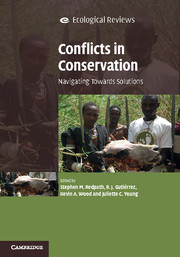Book contents
- Frontmatter
- Dedication
- Contents
- List of contributors
- Foreword by Georgina Mace
- Acknowledgements
- Part I Introduction to conservation and conflict
- 1 An introduction to conservation conflicts
- 2 Philosophy, conflict and conservation
- PART II Contrasting disciplinary approaches to the study of conflict in conservation
- Part III Approaches to managing conflicts
- Index
- Plate Section
- References
1 - An introduction to conservation conflicts
from Part I - Introduction to conservation and conflict
Published online by Cambridge University Press: 05 May 2015
- Frontmatter
- Dedication
- Contents
- List of contributors
- Foreword by Georgina Mace
- Acknowledgements
- Part I Introduction to conservation and conflict
- 1 An introduction to conservation conflicts
- 2 Philosophy, conflict and conservation
- PART II Contrasting disciplinary approaches to the study of conflict in conservation
- Part III Approaches to managing conflicts
- Index
- Plate Section
- References
Summary
The conservation of biodiversity is an increasingly challenging endeavour. Current pressures from a growing human population have led to concerns of a sixth mass extinction event, bringing mounting pressure to find effective ways of conserving biodiversity (Barnosky et al., 2011). However, our ability to meet this challenge is affected by the fact that not everyone supports conservation objectives. People naturally have different interests and priorities, some of which may be diametrically opposed to conservation objectives. In some cases, these differences lead to damaging and costly conflicts that we see emerging across the world and which present major challenges to modern conservation (MacDonald and Service, 2007).
At a cursory glance, the conflicts that surface around conservation often appear to be about impact: the impact of carnivores on livestock; the impact of wind farms on birds; or the impact of protected areas on livelihoods. Consequently, a common approach to these problems has been to build robust science and develop an evidence base to understand these impacts and find ways of reducing them, often through technical solutions. This approach, however, rarely works for the simple reason that many of these conflicts are about much more than impact. So even if we can develop the science to quantify impacts and show how they can be reduced, the conflicts can stubbornly persist. Indeed, beneath the surface of any of the conflicts discussed in this book is a complex layering of diverse issues related to different world views, issues of trust, power imbalances or latent historical issues – issues that lie well outside the sphere of the natural sciences. So, if we really want to understand and tackle these thorny problems, we need insights from other disciplines as well as from the practitioners specialising in resolving conflicts.
The growing recognition of the complexity within conflicts has led many authors to suggest more cross-disciplinary approaches, especially through better integration of ecological and social science (Manfredo and Dayer, 2004; Sillero-Zubiri et al., 2007; Treves, 2009; Dickman, 2010; White and Ward, 2010).
- Type
- Chapter
- Information
- Conflicts in ConservationNavigating Towards Solutions, pp. 3 - 18Publisher: Cambridge University PressPrint publication year: 2015
References
- 21
- Cited by



